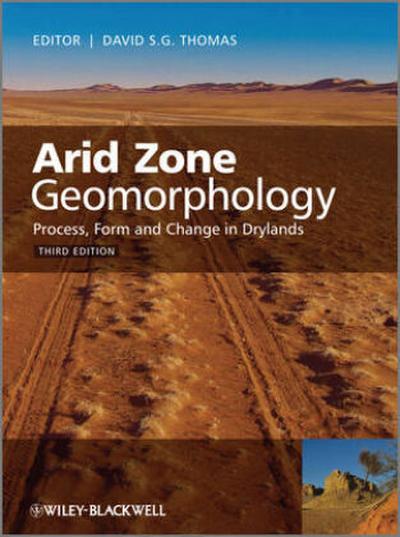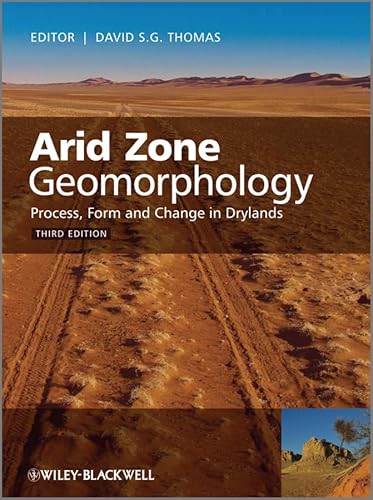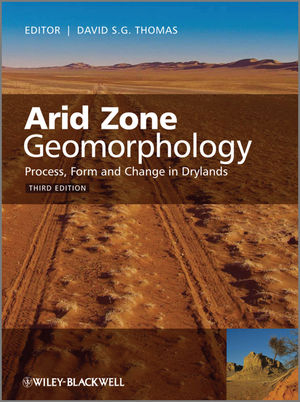
ISBN: 9780470519097
The new edition of Arid Zone Geomorphology aims to encapsulate the advances that have been made in recent years in the investigation and explanation of landforms and geomorphological proc… Altro …
| Indigo.ca new in stock. Costi di spedizione:zzgl. Versandkosten., Costi di spedizione aggiuntivi Details... |

2011, ISBN: 0470519096
[EAN: 9780470519097], New book, [SC: 11.98], [PU: WILEY Mrz 2011], SCIENCE; SCIENCE / EARTH SCIENCES GEOLOGY, Neuware - The new edition of Arid Zone Geomorphology aims to encapsulate the … Altro …
| ZVAB.com AHA-BUCH GmbH, Einbeck, Germany [51283250] [Rating: 5 (of 5)] NEW BOOK. Costi di spedizione: EUR 11.98 Details... |

Arid Zone Geomorphology – Process, Form and Change in Drylands 3e - edizione con copertina flessibile
2011, ISBN: 0470519096
[EAN: 9780470519097], New book, [SC: 6.99], [PU: John Wiley & Sons Inc], 3rd edition. 624 pages. 10.00x7.75x1.50 inches. In Stock., Books
| AbeBooks.co.uk Revaluation Books, Exeter, United Kingdom [2134736] [Rating: 5 (of 5)] NEW BOOK. Costi di spedizione: EUR 6.99 Details... |

Arid Zone Geomorphology – Process, Form and Change in Drylands 3e - edizione con copertina flessibile
2011, ISBN: 9780470519097
Softcover, 3rd edition. 624 pages. 10.00x7.75x1.50 inches., New book, [PU: John Wiley & Sons Inc]
| alibris.co.uk |

2011, ISBN: 9780470519097
Process, Form and Change in Drylands, Buch, Softcover, 3rd Edition, [PU: John Wiley & Sons Inc], John Wiley & Sons Inc, 2011
| lehmanns.de Costi di spedizione:Versand in 10-15 Tagen. (EUR 0.00) Details... |


ISBN: 9780470519097
The new edition of Arid Zone Geomorphology aims to encapsulate the advances that have been made in recent years in the investigation and explanation of landforms and geomorphological proc… Altro …

David S. G. Thomas:
Arid Zone Geomorphology: Process, Form and Change in Drylands - edizione con copertina flessibile2011, ISBN: 0470519096
[EAN: 9780470519097], New book, [SC: 11.98], [PU: WILEY Mrz 2011], SCIENCE; SCIENCE / EARTH SCIENCES GEOLOGY, Neuware - The new edition of Arid Zone Geomorphology aims to encapsulate the … Altro …

Arid Zone Geomorphology – Process, Form and Change in Drylands 3e - edizione con copertina flessibile
2011
ISBN: 0470519096
[EAN: 9780470519097], New book, [SC: 6.99], [PU: John Wiley & Sons Inc], 3rd edition. 624 pages. 10.00x7.75x1.50 inches. In Stock., Books
Arid Zone Geomorphology – Process, Form and Change in Drylands 3e - edizione con copertina flessibile
2011, ISBN: 9780470519097
Softcover, 3rd edition. 624 pages. 10.00x7.75x1.50 inches., New book, [PU: John Wiley & Sons Inc]

2011, ISBN: 9780470519097
Process, Form and Change in Drylands, Buch, Softcover, 3rd Edition, [PU: John Wiley & Sons Inc], John Wiley & Sons Inc, 2011
Dati bibliografici del miglior libro corrispondente
| Autore: | |
| Titolo: | |
| ISBN: |
Informazioni dettagliate del libro - Arid Zone Geomorphology by David S. G. Thomas Paperback | Indigo Chapters
EAN (ISBN-13): 9780470519097
ISBN (ISBN-10): 0470519096
Copertina flessibile
Anno di pubblicazione: 2011
Editore: David S. G. Thomas
Lingua: eng/Englisch
Libro nella banca dati dal 2012-02-19T12:46:16+01:00 (Zurich)
Pagina di dettaglio ultima modifica in 2023-06-16T22:58:27+02:00 (Zurich)
ISBN/EAN: 9780470519097
ISBN - Stili di scrittura alternativi:
0-470-51909-6, 978-0-470-51909-7
Stili di scrittura alternativi e concetti di ricerca simili:
Autore del libro : david thomas
Titolo del libro: arid zone geomorphology, form and process geomorphology, the she zone, zone one, drylands
Dati dell'editore
Autore: David S. G. Thomas
Titolo: Arid Zone Geomorphology - Process, Form and Change in Drylands
Editore: Wiley; John Wiley & Sons
648 Pagine
Anno di pubblicazione: 2011-03-04
Peso: 1,390 kg
Lingua: Inglese
71,90 € (DE)
Not available (reason unspecified)
189mm x 246mm x 34mm
BC; Hardcover, Softcover / Geowissenschaften/Geologie; Geomorphologie, geologische Oberflächenprozesse; Earth Sciences; Geographie; Geography; Geologie u. Geophysik; Geology & Geophysics; Geomorphologie; Geomorphology; Geowissenschaften; Physical Geography; Physiogeographie; Trockengebiet; Geologie u. Geophysik; Geomorphologie; Physiogeographie; BB
List of contributors. Preface to the first edition. Preface to the second edition. Preface to the third edition. I Large-scale controls and variability in drylands. 1 Arid environments: their nature and extent (David S.G. Thomas). 1.1 Geomorphology in arid environments. 1.2 Arid zone distinctiveness and the quest for explanation. 1.3 Arid zones: terminology and definitions. 1.4 The age of aridity on Earth. 1.5 The distribution of arid zones. 1.6 Causes of aridity. 1.7 Climate variability. 1.8 Dryland ecosystems. 1.9 Arid zone geomorphology and people. 1.10 Organisation of this book. 2 Tectonic frameworks (Helen Rendell). 2.1 Introduction. 2.2 Tectonic setting of drylands. 2.3 Uplift and erosion, subsidence and sedimentation. 2.4 Lengths of record. 2.5 Existing erosional and depositional records in arid environments. 2.6 Selected examples of the geomorphological impact of active tectonics in arid environments. 2.7 Conclusions. 3 Climatic frameworks: legacies from the past (David S.G. Thomas and Sallie L. Burrough). 3.1 Introduction. 3.2 The significance of arid zone fluctuations in the past. 3.3 Dating arid zone fluctuations. 3.4 Climatic interpretations and issues. 3.5 Conclusions. 4 Dryland system variability (David S. G. Thomas). 4.1 A framework for dryland diversity. 4.2 Geomonotony: how unvarying are the 'flat' drylands of the world? 4.3 Within-dryland diversity. 4.4 Summary issues. 5 Extraterrestrial arid surface processes (Jonathan Clarke). 5.1 Introduction. 5.2 What does 'aridity' mean beyond Earth? 5.3 Why should planetary scientists understand terrestrial arid geomorphology? 5.4 What can terrestrial geomorphologists learn from a solar system perspective? 5.5 Mars: water-based aridity. 5.6 Titan: methane-based aridity? 5.7 Venus: extreme aridity. 5.8 Future Directions. II Surface processes and characteristics. 6 Weathering systems (Heather A. Viles). 6.1 Introduction. 6.2 What makes arid environments unusual in terms of weathering systems? 6.3 Theoretical underpinnings of weathering systems research. 6.4 Current weathering study methods. 6.5 Linking processes to form in arid weathering systems. 6.6 Explaining the development of weathering landforms in arid environments. 6.7 Weathering rates in arid environments. 6.8 Arid weathering and landscape evolution. 6.9 Scale and arid weathering systems. 7 Desert soils (David L. Dunkerley). 7.1 Introduction: the nature and significance of desert soils. 7.2 Taxonomy of desert soils. 7.3 Some distinctive aspects of desert soil development. 7.4 Stone-mantled surfaces and desert pavements. 7.5 Inorganic seals at the soil surface. 7.6 Vesicular soil structures. 7.7 Conclusions. 8 Desert crusts and rock coatings (David J. Nash). 8.1 Introduction. 8.2 Sodium nitrate deposits. 8.3 Halite crusts. 8.4 Gypsum crusts. 8.5 Calcrete. 8.6 Silcrete. 8.7 Desert rock coatings. 8.8 Palaeoenvironmental significance of crusts. 9 Pavements and stone mantles (Julie E. Laity). 9.1 Introduction. 9.2 Surface types: hamadas and stony surfaces. 9.3 General theories concerning stony surface formation. 9.4 Stone pavement characteristics. 9.5 Processes of pavement formation. 9.6 Processes of clast size reduction in pavements. 9.7 Secondary characteristics of pavement surfaces and regional differences in pavement formation. 9.8 Secondary modifications to pavement surfaces. 9.9 Ecohydrology of pavement surfaces. 9.10 Relative and absolute dating of geomorphic surfaces based on pavement development. 9.11 Conclusions. 10 Slope systems (John Wainwright and Richard E. Brazier). 10.1 Introduction. 10.2 Badlands. 10.3 Rock slopes. 10.4 Conclusion. III The work of water. 11 Runoff generation, overland flow and erosion on hillslopes (John Wainwright and Louise J. Bracken). 11.1 Introduction. 11.2 Infiltration processes. 11.3 Factors affecting infiltration. 11.4 Runoff generation. 11.5 Erosion processes on hillslopes. 11.6 Conclusions. 12 Distinctiveness and diversity of arid zone river systems (Stephen Tooth and Gerald C. Nanson). 12.1 Introduction. 12.2 Distinctiveness of dryland rivers. 12.3 Diversity of dryland rivers. 12.4 Reassessing distinctiveness and diversity. 12.5 Conclusions. 13 Channel form, flows and sediments of endogenous ephemeral rivers in deserts (Ian Reid and Lynne E. Frostick). 13.1 Introduction. 13.2 Rainfall and river discharge. 13.3 Ephemeral river channel geometry. 13.4 Fluvial sediment transport. 13.5 Desert river deposits. 13.6 Conclusions. 14 Dryland alluvial fans (Adrian Harvey). 14.1 Introduction: dryland alluvial fans - an overview. 14.2 Process and form on dryland alluvial fans. 14.3 Factors controlling alluvial fan dynamics. 14.4 Alluvial fan dynamics. 14.5 Discussion: significance of dry-region alluvial fans. 15 Pans, playas and salt lakes (Paul A. Shaw and Rob G. Bryant). 15.1 The nature and occurrence of pans, playas and salt lakes. 15.2 Pan hydrology and hydrochemistry. 15.3 Influences of pan hydrology and hydrochemistry on surface morphology. 15.4 Aeolian processes in pan environments. 15.5 Pans and playas as palaeoenvironmental indicators. 16 Groundwater controls and processes (David J. Nash). 16.1 Introduction. 16.2 Groundwater processes in valley and scarp development. 16.3 Groundwater and pan/playa development. 16.4 Groundwater and aeolian processes. IV The work of the wind. 17 Aeolian landscapes and bedforms (David S.G. Thomas). 17.1 Introduction. 17.2 Aeolian bedforms: scales and relationships. 17.3 The global distribution of sand seas. 17.4 The global distribution of loess. 17.5 Dynamic aeolian landscapes in the Quaternary period. 17.6 Conclusions. 18 Sediment mobilisation by the wind (Giles F. S. Wiggs). 18.1 Introduction. 18.2 The nature of windflow in deserts. 18.3 Sediment in air. 18.4 Determining the threshold of grain entrainment. 18.5 Surface modifications to entrainment thresholds and transport flux. 18.6 Modes of sediment transport. 18.7 Ripples. 18.8 Prediction and measurement of sediment flux. 18.9 The role of turbulence in aeolian sediment transport. 18.10 Conclusions. 19 Desert dune processes and dynamics (Nick Lancaster). 19.1 Introduction. 19.2 Desert dune morphology. 19.3 Dune types and environments. 19.4 Airflow over dunes. 19.5 Dune dynamics. 19.6 Dune development. 19.7 Controls of dune morphology. 19.8 Dune patterns. 19.9 Conclusions. 20 Desert dust (Richard Washington and Giles S. F. Wiggs). 20.1 Introduction. 20.2 Key source areas. 20.3 Temporal changes in dust. 20.4 Future climate change. 20.5 Conclusions. 21 Wind erosion in drylands (Julie E. Laity). 21.1 Introduction. 21.2 The physical setting: conditions for wind erosion. 21.3 Conclusions. V Living with dryland geomorphology. 22 The human impact (Nick Middleton). 22.1 Introduction. 22.2 Human impacts on soils. 22.3 Human impacts on sand dunes. 22.4 Human impacts on rivers. 22.5 Cause and effect: the arroyo debate continues. 22.6 Conclusions. 23 Geomorphological hazards in drylands (Giles F. S. Wiggs). 23.1 Introduction. 23.2 Aeolian hazards. 23.3 The aeolian dust hazard. 23.4 Agricultural wind erosion. 23.5 Drainage of inland water bodies. 23.6 Fluvial hazards. 23.7 Conclusions. 24 Future climate change and arid zone geomorphology (Richard Washington and David S. G. Thomas). 24.1 Introduction. 24.2 Climate change projections: basis and uncertainties. 24.3 Overview of global climate change projections in the context of arid zones. 24.3.1 Methods of establishing climate change impacts in arid zones. 24.4 Climate change and dunes. 24.5 Climate change and dust. 24.6 Climate change and fluvial systems. 24.7 Conclusions. Index.Altri libri che potrebbero essere simili a questo:
Ultimo libro simile:
9780470710777 Arid Zone Geomorphology Process, Form and Change in Drylands (Thomas, David S. G.)
- 9780470710777 Arid Zone Geomorphology Process, Form and Change in Drylands (Thomas, David S. G.)
- 9780470519080 Arid Zone Geomorphology ? Process, Form and Change in Drylands 3e (DSG Thomas)
- 9780470213414 Arid Zone Geomorphology (Thomas, David S.G. (ed.))
- 9780470710760 Arid Zone Geomorphology (David S. G. Thomas)
< Per archiviare...



